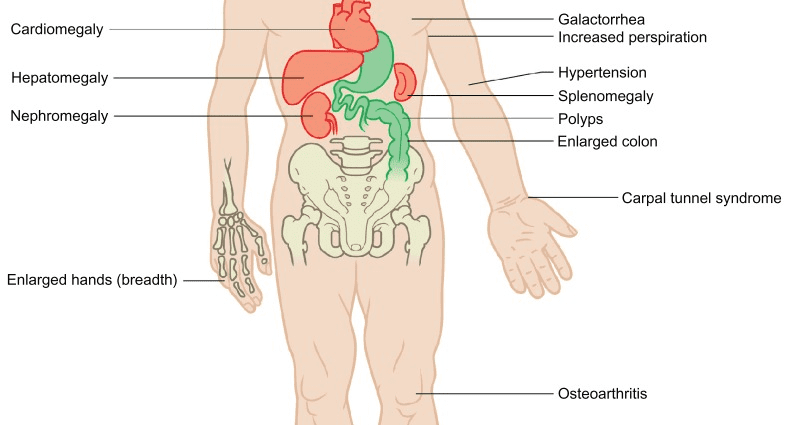Symptoms of acromegaly
1) related to increased production of growth hormone
– The symptoms of acromegaly are linked, in the first place, to the effects of the abnormally high production of GH and of another hormone, IGF-1 (Insulin Growth Factor-1) which is “controlled” by GH :
They understand :
• an increase in the size of the hands and feet;
• a change in the appearance of the face, with a rounded forehead, prominent cheekbones and eyebrow arches, a thickened nose, thickening of the lips, a gaping of the teeth, a thicker tongue, a “galoche” chin;
• joint pain (arthralgia) or back pain (spinal pain), tingling or tingling in the hands associated with carpal tunnel syndrome due to the thickening of the bone in the wrist compressing the median nerve;
• other symptoms, such as excessive sweating, fatigue, hearing loss, change in voice, etc.
2) related to the cause
– Other symptoms are linked to the cause, that is to say, most often to the benign tumor of the pituitary gland which, by increasing the volume of the latter, can compress other brain structures and / or decrease the production of other pituitary hormones:
• headache (headache);
• visual disturbances;
• decrease in the secretion of thyroid hormones causing chilliness, general slowing down, constipation, slowing down of the heartbeat, weight gain, sometimes with the existence of a goiter;
• reduction in the secretion of adrenal hormones (fatigue, loss of appetite, reduction in hair growth, hypotension, etc.);
• decrease in the secretion of sex hormones (menstruation disorder, impotence, infertility, etc.).
3) Others
— The excess GH secretion is sometimes accompanied by increased production of another hormone, prolactin, which can cause breast enlargement in men (gynecomastia), secretion of milk and a decreased libido in both women and men, lengthening or stopping of menstrual cycles in women …
– Acromegaly is often accompanied by other disorders such as diabetes, high blood pressure, sleep apnea, gallbladder stones, nodules, even thyroid cancer, and there is also an excess of colon cancer, hence some additional research sometimes requested (ultrasound of the thyroid, sleep apnea assessment, colonoscopy, etc.).
Symptoms appear very slowly, so the diagnosis is usually only made after several years of development (from 4 to more than 10 years). It is quite often done initially on the physical appearance, when the affected person (or his entourage) notices that he can no longer put on his rings, has changed shoe size and hat size.
Sometimes, too, these are photographs that highlight the abnormal changes in the face over time.










